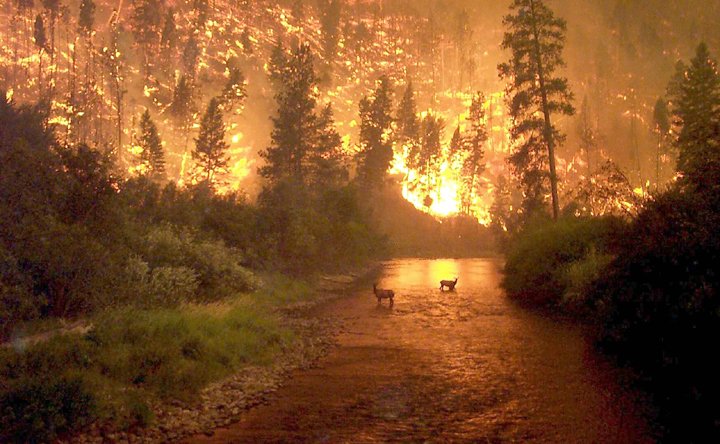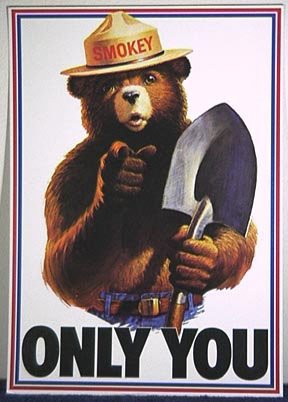Wildfires
Local Weather via the National Weather Service

The threat of wild land fires for people living near wild land areas or using recreational facilities in wilderness areas is real. Advance planning and knowing how to protect buildings in these areas can lessen the devastation of a wild land fire.
- Learn and teach safe fire practices.
- Build fires away from nearby trees or bushes.
- Always have a way to extinguish the fire quickly and completely.
- Never leave a fire - even a cigarette - burning unattended.
- Obtain local building codes and weed abatement ordinances for structures built near wooded areas.
- Use fire-resistant materials when building, renovating, or retrofitting structures.
- Create a safety zone to separate the home from combustible plants and vegetation.
- Stone walls can act as heat shields and deflect flames.
- Swimming pools and patios can be a safety zone.
- Check for fire hazards around home.
- Install electrical lines underground, if possible. Keep all tree and shrub limbs trimmed so they don't come in contact with the wires.
- Prune all branches around the residence to a height of 8 to 10 feet. Keep trees adjacent to buildings free of dead or dying wood and moss.
- Remove all dead limbs, needles, and debris from rain gutters.
- Store combustible or flammable materials in approved safety containers and keep them away from the house.
- Keep chimney clean.
- Avoid open burning completely, and especially during dry season.
- Install smoke detectors on every level of your home and near sleeping areas.
- Make evacuation plans from home and from neighborhood.
- Plan several routes in case the fire blocks escape route.
- Have disaster supplies on hand:
- Flashlight with extra batteries
- Portable, battery-operated radio and extra batteries
- First aid kit and manual
- Emergency food and water
- Nonelectric can opener
- Essential medicines
- Cash and credit cards
- Sturdy shoes
- Develop an emergency communication plan. In case family members are separated from one another during a wild land fire (a real possibility during the day when adults are at work and children are at school), have a plan for getting back together.
- Ask an out-of-state relative or friend to serve as the "family contact." After a disaster, it's often easier to call long distance. Make sure everyone knows the name, address, and phone number of the contact person.
Fire-Resistant Building Materials

Avoid using wooden shakes and shingles for a roof. Use tile, stucco, metal siding, brick, concrete block, rock, or other fire-resistant materials. Use only thick, tempered safety glass in large windows and sliding glass doors.
Contact your local emergency management office or American Red Cross chapter for more information on wild land fires.
During
- Turn on a battery-operated radio to get the latest emergency information.
- Remove combustible items from around the house.
- Lawn and poolside furniture
- Umbrellas
- Tarp coverings
- Firewood
- Take down flammable drapes and curtains and close all venetian blinds or noncombustible window coverings.
- Take action to protect your home.
- Close all doors and windows inside your home to prevent draft.
- Close gas valves and turn off all pilot lights.
- Turn on a light in each room for visibility in heavy smoke.
- Place valuables that will not be damaged by water in a pool or pond.
- If hoses and adequate water are available, leave sprinklers on roofs and anything that might be damaged by fire.
- Be ready to evacuate all family members and pets when fire nears or when instructed to do so by local officials.
After
Take care when re-entering a burned wild land area. Hot spots can flare up without warning. Check the roof immediately and extinguish any sparks or embers. Check the attic for hidden burning sparks. For several hours afterward, re-check for smoke and sparks throughout the home.
If trapped in a Wild land Fire
You cannot outrun a fire. Crouch in a pond or river. Cover head and upper body with wet clothing. If water is not around, look for shelter in a cleared area or among a bed of rocks. Lie flat and cover body with wet clothing or soil.
Breathe the air close to the ground through a wet cloth to avoid scorching lungs or inhaling smoke.
Mitigation
Mitigation includes any activities that prevent an emergency, reduce the chance of an emergency happening, or lessen the damaging effects of unavoidable emergencies. Investing in preventive mitigation steps now such as installing a spark arrestor on your chimney, cleaning roof surfaces and gutters regularly, and using only fire resistant materials on the exterior of your home, will help reduce the impact of wild land fires in the future. For more information on mitigation, contact your local emergency management office.
Did You Know...
- More than four out of every five forest fires are started by people. Negligent human behavior such as smoking in forested areas or improperly extinguishing campfires are the cause of many fires. The other cause of forest fires is lightning.
- A prescribed fire is a fire that is purposely ignited by land management agencies under controlled conditions for specific management objectives.
- The 1991 wild land fires in Oakland, California, caused 26 deaths and 148 injuries. The fires destroyed over 3,000 structures, left over 5,000 people homeless and resulted in $1.5 billion in damages.
- In 1990, hot, dry weather conditions in California contributed to brush fires in Santa Barbara County that destroyed more than 600 buildings, caused over $200 million of damage and killed one person.
- The greater Yellowstone National Park fire of 1988 destroyed or damaged private structures, including 17 mobile homes, 4 dwellings, a general store, 12 garages and outbuildings, 19 cabins, and several storage structures, and burned 1,210,730 acres of wild land.
